If you’ve ever strolled by an Indian water body, you’ve likely spotted the Indian Pond Heron. It’s a fascinating bird known for its remarkable camouflage and stealth. Often mistaken for a typical rock or debris, it’s a master of disguise in the avian world.
The Indian Pond Heron, or Ardeola grayii, is native to the Indian subcontinent and Southeast Asia. It’s a small heron with a white throat, brown-streaked wings, and a yellow bill.
What sets it apart is its unique hunting style. It’s patient, often standing still for long before making a lightning-fast strike on unsuspecting prey.
In the following article, we’ll delve deeper into the life of the Indian Pond Heron. From its habitat and diet to its nesting habits, we’ll uncover the secrets of this elusive bird. So, let’s embark on this journey and get to know the Indian Pond Heron better.
Habitat of the Indian Pond Heron
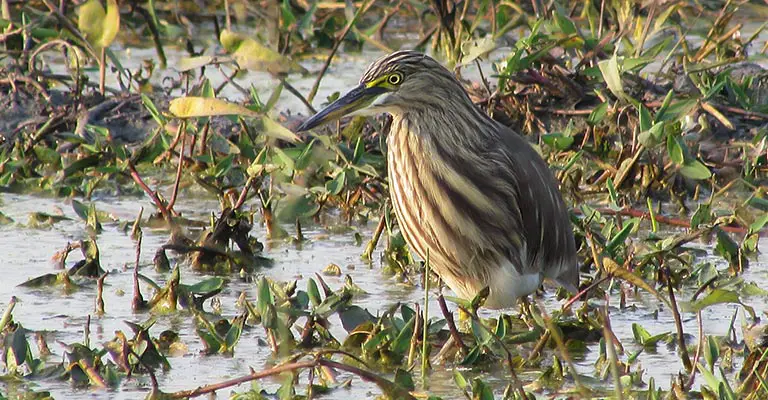
The Indian Pond Heron, scientifically known as Ardeola grayii, is a versatile bird found across a broad geographical range spanning from Iran to Burma and Sri Lanka, with its primary habitat being in India and Sri Lanka.
As their name suggests, they are typically associated with watery environments but exhibit adaptability to various habitats.
Here’s an overview of their habitat preferences:
Wetlands
Indian Pond Herons prefer shallow water bodies such as ponds, marshes, rivers, lakes, and man-made water sources like paddy fields and reservoirs.
These environments provide ample foraging opportunities, as their primary diet consists of aquatic prey such as fish, amphibians, and insects.
Urban Areas
Despite their affinity for natural wetlands, Indian Pond Herons are also commonly found in urban areas. They frequent park ponds, city water features, and other human-made aquatic environments.
Their adaptability to urban landscapes allows them to exploit new food sources and nesting sites, contributing to their widespread presence in diverse surroundings.
Altitudinal Range
While they primarily inhabit lowland areas, Indian Pond Herons can reside at considerable altitudes, reaching heights of up to 4,000 meters in the Himalayas during the summer.
This ability to thrive in diverse altitudinal ranges further highlights their adaptability to varying environmental conditions.
Seasonal Migration
While many Indian Pond Herons are residents in their respective habitats throughout the year, some individuals migrate based on local weather patterns and food availability.
This seasonal movement allows them to optimize their survival strategies and exploit favorable conditions in different regions.
The table below briefly describes their global spread:
| Geographical Range | Details |
|---|---|
| Primary Range | India, Sri Lanka |
| Secondary Range | Iran, Burma |
| Migration Pattern | Stay resident, some migrate per local conditions |
| Altitude Range | Up to 4,000 meters |
Physical Characteristics of the Indian Pond Heron
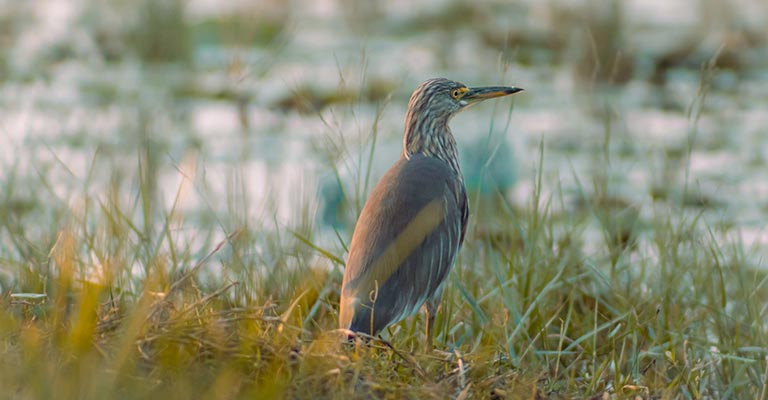
The Indian Pond Heron, scientifically known as Ardeola grayii, exhibits various physical characteristics contributing to its adaptability and survival in multiple habitats.
Here’s an overview:
Size
Indian Pond Herons are small to medium-sized birds, typically measuring 40-50 cm long. This size range allows them to maneuver effectively in terrestrial and aquatic environments.
Coloration
- Non-breeding Season: During the non-breeding season, their plumage predominantly appears brown, aiding in camouflage against their surroundings, particularly near water bodies where they typically reside.
- Breeding Season: In contrast, their appearance undergoes a remarkable transformation during the breeding season. They display a vivid breeding plumage characterized by metallic green and purple hues on their back mantle, enhancing their visual appeal.
Distinct Features
- Camouflage: Their ability to blend into their surroundings, especially during the non-breeding season, is facilitated by their predominantly brown plumage.
- Breeding Plumage: The prominent crest and back mantle adorned with metallic colors during the breeding season are distinctive features that enhance their attractiveness and signaling during mating rituals.
Eyes
The Indian Pond Heron’s eyes are predominantly yellow with a reddish tinge, contributing to their excellent vision. This keen eyesight aids in hunting prey and navigating their environment effectively.
Beak
These birds, equipped with a sharp beak, use it as their primary tool for catching and consuming prey, showcasing their efficiency in hunting.
Legs
During the breeding season, their legs turn noticeably pink. This adaptation allows them to wade through shallow water bodies easily, a behavior essential for foraging and nesting in their preferred habitats.
Hunting Behavior of the Indian Pond Heron
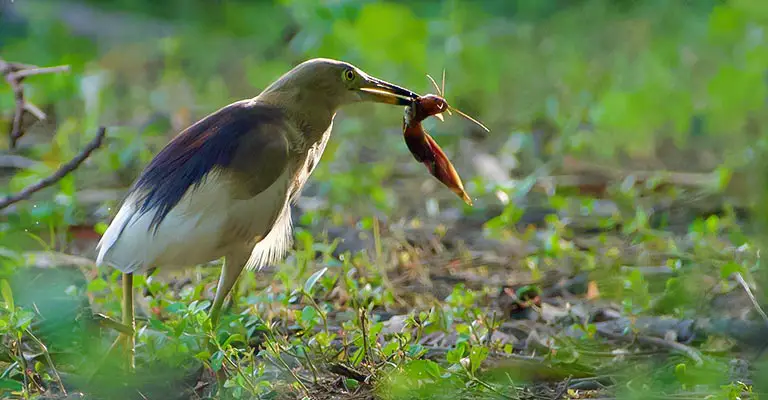
The hunting behavior of the Indian Pond Heron is indeed remarkable, showcasing a blend of stealth, precision, and adaptability that allows them to thrive in their wetland habitats.
Here’s a summary of their hunting techniques and strategies:
Sit-and-Wait Approach
Indian Pond Herons primarily employ a “sit-and-wait” hunting strategy. They patiently stand still near water bodies, maintaining a low profile and remaining virtually invisible to passing prey.
Camouflage
Their brown and white plumage provides excellent natural camouflage, helping them blend seamlessly into their surroundings, particularly during non-breeding seasons. This camouflage allows them to ambush unsuspecting prey effectively.
Swift Attack
When prey comes within striking range, Indian Pond Herons launch rapid attacks using their sharp beaks. This swift motion leaves little to no chance for the prey to escape, demonstrating the bird’s precision and speed in capturing food.
Diet
Their diet primarily consists of insects, small fish, crustaceans, and amphibians in their wetland habitats. They may also feed on small mammals and reptiles, showcasing their dietary flexibility.
Pink Legs
The pink coloration of their legs, particularly noticeable during the breeding season, aids in camouflage as they wade through water bodies in search of prey. This blending with their surroundings further enhances their ability to remain undetected by potential prey.
Nesting Habits of Indian Pond Herons
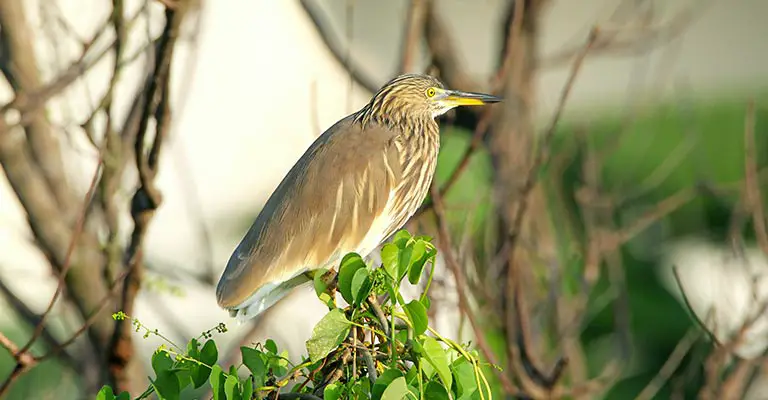
The nesting habits of the Indian Pond Heron reveal a fascinating aspect of their reproductive behavior and social dynamics within their colonies. Here’s a closer look at their nesting habits:
Colonial Nesting
Indian Pond Herons exhibit a communal nesting behavior, often forming large colonies for breeding purposes. These colonies are typically established on trees near water bodies such as rivers, lakes, and ponds.
Within these colonies, multiple nests can be found in a single tree, and they often share the nesting space with other waterbirds.
Nest Construction
Nests are constructed using sticks and twigs, built in the forks of trees. The communal nesting arrangement efficiently utilizes space and resources within the colony.
Breeding Season
The nesting season typically occurs during the warmer months. Pairs of Indian Pond Herons lay an average of 3 to 5 pale greenish-blue eggs in each clutch.
Incubation and Parental Care
Both parents are responsible for incubating the eggs, lasting approximately 22-28 days. During this incubation period, the parents also take turns guarding the nest and protecting it from potential threats, such as predators or human disturbance.
Learning and Development
The communal nesting behavior of Indian Pond Herons likely plays a significant role in the socialization and development of their offspring.
Young herons learn essential skills, including hunting and survival techniques, through observation and interaction with their parents and other colony members.
Conservation Status of the Indian Pond Heron
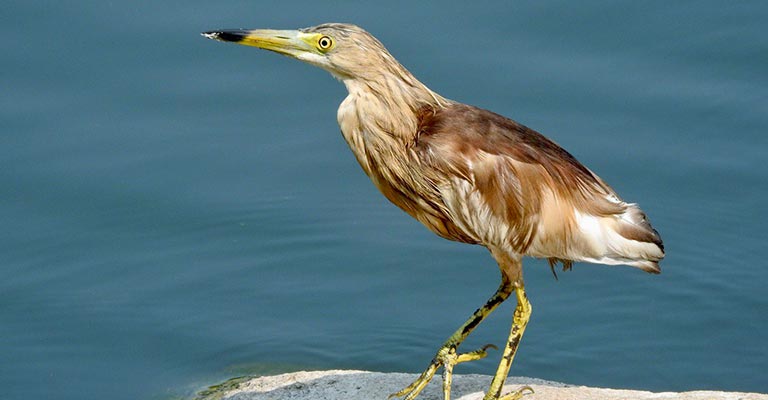
The conservation status of the Indian Pond Heron is a matter of concern due to various threats impacting its population.
Despite being classified as “Least Concern” by the International Union for Conservation of Nature (IUCN) primarily due to its extensive range, the species faces significant challenges driving its numbers downwards.
Habitat Loss
The destruction of wetlands for agricultural expansion and human development activities severely threatens the Indian Pond Heron. Wetlands, crucial habitats for these herons, are transformed into agricultural fields, residential areas, and commercial infrastructures.
Egg Harvesting
Despite legal protection, the harvesting of eggs and chicks by local communities contributes to the decline in population numbers. Lax enforcement of regulations exacerbates this threat.
Kazooing
The illegal harvesting of feathers, particularly in India, also affects the population of these herons. While not as severe as habitat loss or egg harvesting, it still poses a significant threat.
Pollution
Although listed as a lower threat than habitat loss and egg harvesting, pollution still impacts the Indian Pond Heron’s habitat and food sources. Pollution in wetlands can lead to reduced prey availability and habitat degradation.
Conclusion
It’s clear that the Indian Pond Heron’s plight is more dire than what their “Least Concern” status suggests. The rising threats from human activities are causing a steady decline in their population.
It’s not just about saving a species – it’s about preserving the balance of our ecosystems. We must ramp up our efforts to protect these herons. Stricter enforcement of laws, coupled with increased public awareness, is crucial.
We also need to adopt sustainable living practices to reduce habitat loss. Remember, every creature plays a pivotal role in the environment, and the Indian Pond Heron is no exception.
By safeguarding them, we’re ensuring their survival and contributing to a healthier, more balanced planet.